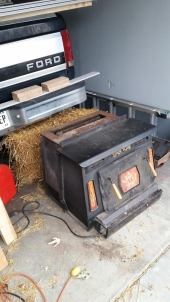
 1
1




Evolve.
Dirtling Farm https://www.youtube.com/channel/UCWN8bHd4A0uMW8kF_v4J7GA





For all your Montana Masonry Heater parts (also known as) Rocket Mass heater parts.
Visit me at
dragontechrmh.com Once you go brick you will never go back!

 1
1




God of procrastination https://www.youtube.com/watch?v=q1EoT9sedqY




Life on a farm is a school of patience; you can't hurry the crops or make an ox in two days.
Henri Alain
 1
1




Evolve.
Dirtling Farm https://www.youtube.com/channel/UCWN8bHd4A0uMW8kF_v4J7GA
 2
2








Polychlorinated dioxins and furans (PCDD/PCDF or PCDD/F) are a group of
highly toxic components. They are found to be a consequence of the de novo synthesis
in the temperature range within 180°C and 500°C [23]. Carbon, chlorine,
catalysts (Cu) and oxygen are necessary for the formation of PCDD/F, so PCDD/F
can be formed in very small amounts from all biomass fuels containing chlorine.
The emissions of PCDD/F are highly dependent on the conditions under which
combustion and flue gas cooling take place; therefore, wide variations are found
in practice. Although herbaceous biomass fuels have high chlorine contents, their
PCDD/F emissions are usually very low. This may be explained by their high
alkali content, which leads to the formation of salts (KCl, NaCl) and thus to a
lower level of gaseous chlorine for the de novo synthesis. Because of the many
factors influencing PCDD/F formation, wide variations may appear even within
the same biomass combustion installation, but in general, the PCDD/F emission
level from biomass combustion applications using virgin wood as a fuel is well
below the health risk limit.




Evolve.
Dirtling Farm https://www.youtube.com/channel/UCWN8bHd4A0uMW8kF_v4J7GA








Evolve.
Dirtling Farm https://www.youtube.com/channel/UCWN8bHd4A0uMW8kF_v4J7GA




Platinum and palladium may catalyze chlorination of PCDD/Fs via the Deacon reaction or an oxidation process.
 1
1




Evolve.
Dirtling Farm https://www.youtube.com/channel/UCWN8bHd4A0uMW8kF_v4J7GA

|
Men call me Jim. Women look past me to this tiny ad:
Learn Permaculture through a little hard work
https://wheaton-labs.com/bootcamp
|







